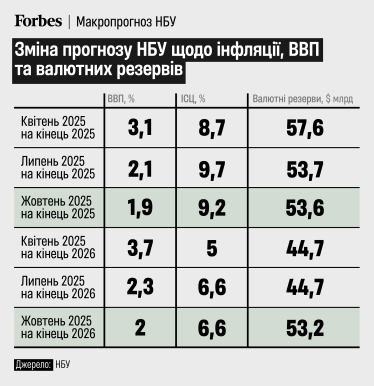““`html The National Bank has kept the discount rate at 15.5% since April 2025, despite its own predictions regarding its reduction from October 2025. Is the regulator’s monetary policy too strict – the kind that slows down economic growth? Viktor Kozyuk, head of the Department of Economics and Global Studies at the Western Ukrainian National University, tells us Buy an annual subscription to six Forbes Ukraine magazines at cost […]”, — write: businessua.com.ua

The National Bank has kept the discount rate at 15.5% since April 2025, despite its own predictions regarding its reduction from October 2025. Is there monetary credit? Is the policy of the regulator excessively strict – such that it inhibits economic growth? Victor Kozyuk, head of the Department of Economics and Global Studies of the West Ukrainian National University, tells the story
Purchase an annual subscription for six Forbes Ukraine magazines by value four issues If you prefer the quality, depth and power of hands-on experience, this is it subscription just for you
The next decision of the National Bank to fix the discount rate at 15.5% contradicted its previous forecast. He assumed that the regulator will start reducing the rate already in October. However, this decision was not unexpected, given the state of the economy and geopolitics.
It is no coincidence that a large number of experts interviewed by the ICU on the eve of the announcement of the decision on October 23 believed that it was advisable to keep the discount rate unchanged (despite the fact that they expected the NBU to lower it). But it was not without controversy.

popular Company Category Date Today $100 million in 15 months. NABU has been monitoring Kvartal 95 co-owner Timur Mindich for more than a year in the case of possible corruption in Energoatom. What was installed?
Why is the NBU’s cautious policy justified under the current circumstances?
Data-driven policy Together with the decision on the discount rate, the NBU updated its macroeconomic forecast. It shows that the situation in 2025–2027 does not look clear-cut – multidirectional signals are observed.

Change in the forecast of the NBU regarding inflation, GDP and currency reserves. Sources: NBU data, Viktor Kozyuk’s calculations
On the one hand, the economic predictions for the end of 2025 and 2026 only worsened. On the other hand, the inflation forecast worsened in July for 2025 and the end of 2026, but slightly improved in October.
The change in the forecast for international reserves is also non-linear. During 2025, the forecast values decrease, but in October there was an improvement for 2026. The latter rather shows that there are certain assurances regarding international funding for the coming years. This is definitely a positive signal.
Is this information enough for the NBU to lower the discount rate?
The textbook says that, in a data-driven policy sense, there are reasons to believe that the rate cut could start as early as October. Such an argument is suggested from a superficial reading of the Taylor equation, which purely relates the central bank rate to the deviation of inflation from the target and actual GDP from its potential value.
Simply put, if the inflation forecast improves and the GDP forecast worsens, the rate needs to be cut.
When there is reason to cut the rate, but the central bank does not, a critical view of the reasons for such a decision arises: either the policy is not based on data, or the central bank is sending a negative signal about the actual state of affairs.
Is such an interpretation perfect? Not quite. In fact, the algorithm for interpreting the actions of central banks contains a significant share of dangerous distortions in the understanding of monetary decisions.
On the one hand, the arguments are based on a technical approach, and therefore look professional. On the other hand, they are too conspiratorial about hidden signals. Thus, the expectations of market participants and specialists may cause a negative reaction.
Another negative manifestation of quick decisions based on updating a narrow set of forecast data is excessive volatility of the key rate.
Thus, if the central bank made a mistake and made a decision relying on a certain set of data, it would be necessary to expand the monetary conditions soon, relying on the emergence of new information about the state and prospects of the economy.
That is, by reducing the rate now, the NBU would risk increasing it in the near future, and this is a huge stone in the direction of trust in the actions of the regulator.
Can data-driven policy be considered more broadly? Certainly. A data-based approach to monetary policy does not exclude another interpretation.
So, first of all, the deterioration of the GDP forecast is a consequence not so much of the rigidity of monetary conditions of the previous period, but of the impact of non-economic factors that became more active during the updating of forecasts. One of the examples is the beginning of large-scale shelling of the energy system of Ukraine by the Russians.
Secondly, the possibility of pressure on the further dynamics of inflation remains. It takes place both on the demand side and on the cost side.
Thirdly, the risks related to the rhythmicity of the inflow of international financing should not be dismissed, as evidenced by significant changes in the forecasts of foreign exchange reserves over the past few years.
That is, the balance of risks for the inflationary trajectory is such that the maintenance of current monetary conditions looks uncontroversial and corresponds to the data. However, the discount rate will not be excessively variable.
Also, a data-based approach to monetary policy necessarily involves a number of extremely important points:
- degree of deviation of inflation from the target;
- anchoring of inflationary expectations;
- inertia of inflation;
- the nature of monetary transmission, etc.
It is from such nuances, which go beyond the published forecasts, that the monetary reaction of the central bank will depend.
In the case of the NBU, the decision to postpone the reduction of the discount rate was most likely made precisely in the context of the fact that:
- inflation significantly exceeds the NBU’s target of 5%, and even an improvement in the forecast does not indicate that the latter will be reached next year;
- inflation expectations may turn out to be unstable and there is a risk of their “stuck” at levels that will make it difficult to achieve the inflation target if the discount rate is lower;
- the inertia of expectations, when they are overestimated, requires maintaining a higher discount rate, which is not desirable for a long time due to the need to create space for increasing lending;
- monetary transmission works with delays in conditions of hypertrophy of bank liquidity, etc.
Is there mo Is the bad policy of the NBU overly rigid (the kind that restrains economic development)? The current phase of monetary conditions can hardly be called one that tests the limits of rigidity.
During 2025, the increase in the discount rate took place at rates that are comparable or even inferior to those in 2018 and 2021. 2022 is not taken into account in this context. This is despite the fact that the inflation rate and its deviation from the target were lower then than now.
The discount rate in real terms has also increased at a commensurate pace since 2018, but at the same time is at lower levels.

The NBU discount rate and inflation. Sources: NBU data, Viktor Kozyuk’s calculations
That is, if we compare the episodes of strengthening monetary conditions in 2018–2019, 2021 and 2025 (except for the exceptional years 2022–2023), the current case shows that the monetary policy of the NBU looks more flexible, if not softer.
Of course, the arguments of the slow recovery of the economy, the need to increase the financing of the real sector, budgetary needs and better supply of reserves play in favor of this. In the light of this postponement of the cycle, the reduction of the discount rate seems quite justified.
So, apart from the war, the biggest challenge to monetary policy today is not so much the timing of the selection of policy turning points as the optimal combination of the level of the discount rate and currency reserves with the aim of unconditionally ensuring macro-financial stability in conditions of uncertainty.
“`
The source
Please wait…
